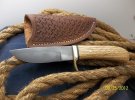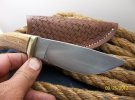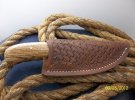- Joined
- Jul 8, 2008
- Messages
- 1,079
this was forged from 52100e 1" round stock from mcmaster carr. this steel has given me so much performance from every blade that I handforged with it that I took 2 weeks to build a power hammer just to be able to work this steel and the larger diameter steel that I have from them! knives from this steel are the best performing blades that I have ever made by far!
OAL- 8 3/4"
blade- 4 1/4" long, .200" thick, 1 1/16" wide at the guard
steel- 52100e from a 1" round bar from mcmaster Carr, Forged, with in-house differential heat treatment which includes triple post forging quences, triple normalize, triple anneal, triple edge quench, and triple draw, with 24 hour freezer cycles between thermal events, for the highest performing blade that I can make, that holds a incredible edge, and yet is easy to sharpen!
grind- a full convex grind, with distal taper, sharpened on a Norton Fine India stone with micro bevels, to an agressive razor edge
finish- etcted 1000 grit finish, with a light hamon or temper line
handle- purpleheart with a 600 grit tung oil finish, and black paper micarta spacer
guard- 1/4" brass, nicely contoured to feel good on the finger, for greater control, and saftey in challenging situations, and 1/8" brass pins
sheath- 11oz leather, hand stitched, hand tooled, hot-waxed, with cam, for "snap fit", 3 copper rivets for belt loop. Sheath holds blade securely even when upside down, yet allows instant draw, and is easy to re-sheath one handed.
blade fully tested for edge retention and tip strenth before finishing! The blade is subjected to an edge flex test, where the edge is flexed over a 1/4" brass rod from both sides to check for toughness. These blades will generally make 200 {at a minimum} slicing cuts in 1/2" manilla rope in my shop on a scale, without requiring more than 35lbs of force to complete each cut, and will typically still shave hair from my arm at the end of the 200 cuts! {your performance may vary due to rope consistancy, sharpening teqnique, sharpening stone condition, and cutting skill} note that they will continue to cut the rope, but I stop cutting and counting when they quit shaving {i tested one to over 400 agressive cuts, thats ALOT of cutting to do for each blade!}. The heat treated blades are dropped point first on a concrete floor from a distance of roughly 4 feet before finishing, the blade must exhibit no substansial damage to pass the "concrete floor test". After a blade passes these tests, only then does it go to the finishing stage.
$240 plus $10 for shiping/insurance to CONUS. I can accept paypal Joe357m@bresnan.net or money order.
1st to post "I'll take it" gets it!!!




Ships within 48 hours of payment priority with ins.
Feedback appreciated, and thanks for looking!
If you would like one like this one or different, PM or email with details!
OAL- 8 3/4"
blade- 4 1/4" long, .200" thick, 1 1/16" wide at the guard
steel- 52100e from a 1" round bar from mcmaster Carr, Forged, with in-house differential heat treatment which includes triple post forging quences, triple normalize, triple anneal, triple edge quench, and triple draw, with 24 hour freezer cycles between thermal events, for the highest performing blade that I can make, that holds a incredible edge, and yet is easy to sharpen!
grind- a full convex grind, with distal taper, sharpened on a Norton Fine India stone with micro bevels, to an agressive razor edge
finish- etcted 1000 grit finish, with a light hamon or temper line
handle- purpleheart with a 600 grit tung oil finish, and black paper micarta spacer
guard- 1/4" brass, nicely contoured to feel good on the finger, for greater control, and saftey in challenging situations, and 1/8" brass pins
sheath- 11oz leather, hand stitched, hand tooled, hot-waxed, with cam, for "snap fit", 3 copper rivets for belt loop. Sheath holds blade securely even when upside down, yet allows instant draw, and is easy to re-sheath one handed.
blade fully tested for edge retention and tip strenth before finishing! The blade is subjected to an edge flex test, where the edge is flexed over a 1/4" brass rod from both sides to check for toughness. These blades will generally make 200 {at a minimum} slicing cuts in 1/2" manilla rope in my shop on a scale, without requiring more than 35lbs of force to complete each cut, and will typically still shave hair from my arm at the end of the 200 cuts! {your performance may vary due to rope consistancy, sharpening teqnique, sharpening stone condition, and cutting skill} note that they will continue to cut the rope, but I stop cutting and counting when they quit shaving {i tested one to over 400 agressive cuts, thats ALOT of cutting to do for each blade!}. The heat treated blades are dropped point first on a concrete floor from a distance of roughly 4 feet before finishing, the blade must exhibit no substansial damage to pass the "concrete floor test". After a blade passes these tests, only then does it go to the finishing stage.
$240 plus $10 for shiping/insurance to CONUS. I can accept paypal Joe357m@bresnan.net or money order.
1st to post "I'll take it" gets it!!!




Ships within 48 hours of payment priority with ins.
Feedback appreciated, and thanks for looking!
If you would like one like this one or different, PM or email with details!
